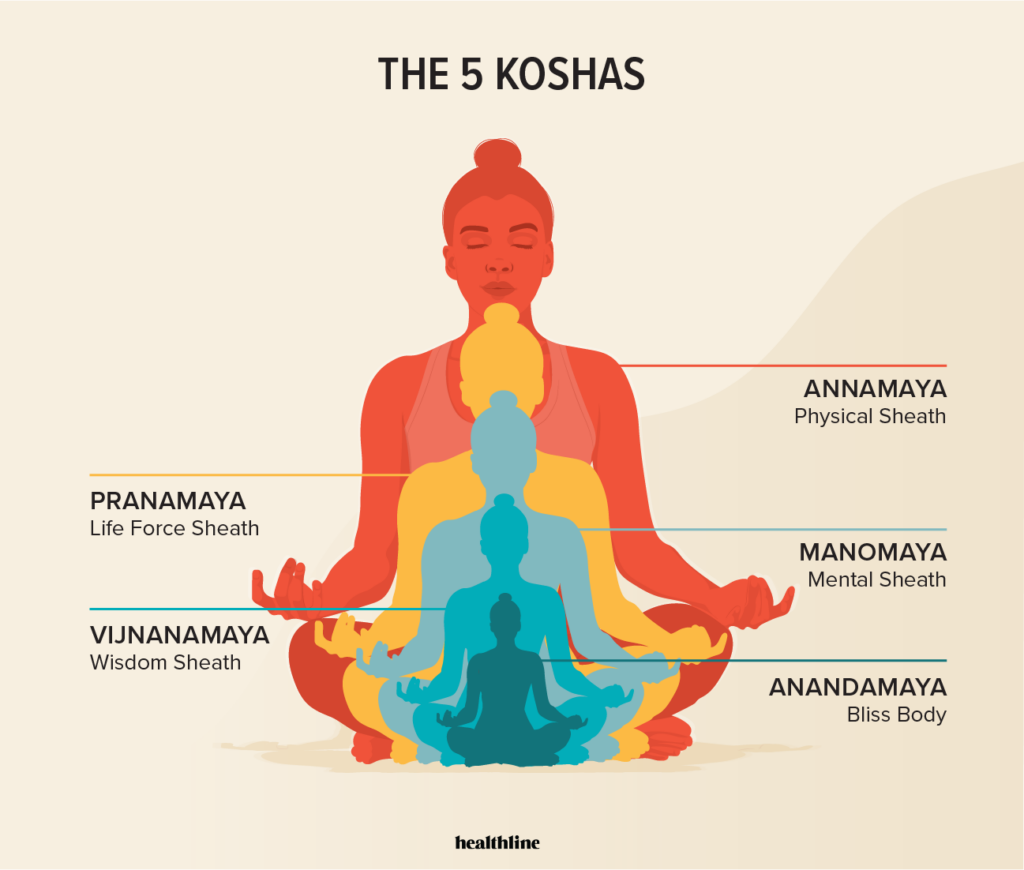For many of us, the physical body or physical motivations are what first brings us to a yoga practice. It is an entry point into Yoga and its philosophy. Many students notice their bodies getting stronger, more flexible, and able to stay upright with better balance and mobility. We may even begin to sleep better and pay closer attention to our diet, fueling our body with nutritious foods. However, if you stick around for a while, you will start to explore the teachings. You’ll discover many yogis are practicing not only for how it makes their bodies look on the outside, but how it makes them feel on the inside. We begin a journey into the spiritual layers of the practice and ourselves.
Yoga offers many models that expand the view of the human experience. One of them is the kosha system, presented in the Tattiriya Upanisad. This ancient text presents the human as containing five koshas, or layers of consciousness. These range from the densest to the subtlest elements of existence encasing the soul like the layers of an onion. When yogis talk of “going inside,” they are usually referring to the innate desire to move their consciousness from the outer layers to the inner layers, experiencing a deep connection with their true Self or soul.
The 5 Koshas or the Five Layers of Being
To understand the koshas, think of a set of five Russian nesting dolls. Each layer can operate separately but is also interconnected and intertwined. There is no separation.
Starting at the outermost, densest layer, and moving inward, the five layers are:
1. Annamaya kosha (physical body): The first layer of consciousness consists of the physical or material body from the food they you eat. It includes the muscles, bones, connective tissue, organs, fat, and skin.
2. Pranamaya Kosha (energy body): The second layer of experience consists of subtle body energy, or the elements that cannot be seen with the naked eye. This vital life force energy (i.e., breath and prana) fills the physical body and takes its shape.
3. Manomaya kosha (mental body): Thoughts and feelings make up the third layer of being. This layer fills the two denser bodies and has the same shape. Most people only consciously operate in these first three layers.

4. Vijnanamaya kosah (wisdom body): The fourth layer is comprised of intuition and wisdom. It is here where we have the ability to connect to higher knowing, to follow intuitive impulses, and see the bigger picture beyond logic. With awareness, we can free ourselves from unhealthy thoughts and actions, and develop the self-control necessary to achieve our goals and serve our highest good.
5. Anandamaya kosha (bliss body): Finally, the fifth layer is the quiet place of pure joy, happiness, and bliss. You can experience this state viscerally rather than intellectually when you feel and know that love is the deepest reality. One of yoga’s greatest gifts is its power to awaken us to our body of bliss.
Your Yoga Practice and the 5 Koshas
The word “yoga” translates to “yoke” or “union.” As a yogi, you may be interested in approaching your practice with curiosity and a desire to experience the wholeness of who you are. That is, to experience all five koshas. Starting with the physical body, you learn that you can access the innermost layers only by going in and through and reach a state of bliss or pure joy.
The journey through the koshas on the yoga mat is intuitive and natural.

- During the first few minutes of a practice, you immediately connect to your physical body (annanamaya kosha) feeling your feet connect to the ground. You may begin with a variety of postures to work through stiffness, soreness, or strength.
- Soon after becoming aware of your physical body, you bring attention to your breath (pranamaya kosha), and how the energy moves through your system. There is a sense of fluidity and flow when you are experiencing this layer since breath and prana are moving energy throughout the entire system. This layer is also known as the bridge between the body and the mind and you connect deeply to this layer when practicing vinyasa or flow.
- After a while, you may notice that focusing on your body and breath helps to calm your mind (manomaya kosha) and move stuck emotions. You may even begin to notice less chatter and more mental silence, creating a sense of peace inside.
- Once your mind experiences a more peaceful state, there is greater access to awareness and wisdom (vijnanamaya kosha). The mental fluctuations seem to slow down even more or stop altogether, and there is space for intuition and greater understanding. The wisdom body, at its subtlest level, is simply awareness – the objective, observing part of self. It is where you can stop identifying with your powerful thoughts and just witness your mind and your life.
- Ending your yoga practice with seated meditation opens you to know the core of your being (anandamaya kosha). The bliss body is the most hidden part of us and may take some time to reveal itself. Yet, its subtle presence is felt knowing that life is worth living and that to be alive is good. It is our true nature to live and experience joy, happiness, and pure bliss.
Whatever brought you to the practice of yoga, you can experience the five layers of being. Think of yoga as a unique opportunity to pause your busy life and peel back the layers of yourself. Yes, yoga will strengthen your core and improve your balance, but it will also help you become aware of your energy. It can calm your mind and bring you a sense of peace. At the highest level, it can bring you to a state of pure joy. The physical, mental, and emotional health benefits of yoga and experiencing the koshas truly cannot be measured.

